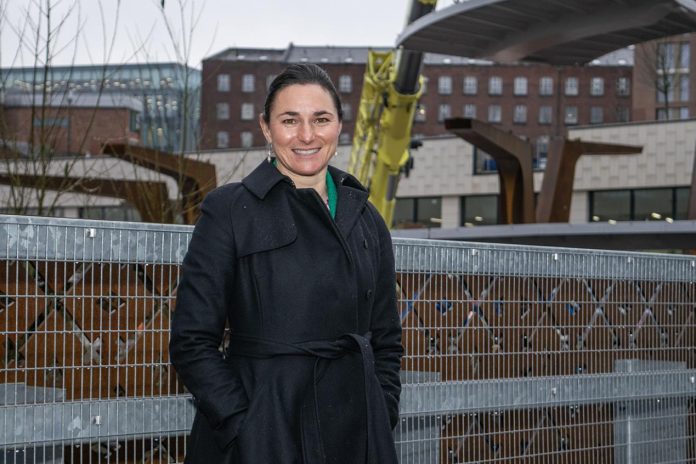Dame Sarah Storey has set out a bold new road map for cycling, walking and wheeling in Greater Manchester, following a major review of active travel infrastructure across the city-region.
Dame Sarah, who was appointed as Active Travel Commissioner in 2022, has today announced the next stage of Greater Manchester’s long-term active travel mission, building on the 10 priorities set out 12 months ago.
The city-region’s plan to build the UK’s largest cycling, walking and wheeling network – known as the Bee Active Network – has been reviewed and brought up-to-date to ensure it will fully-integrate with the wider-Bee Network, Greater Manchester’s vision for a London-style public transport network.
The Bee Active Network, as set out in a new report by Dame Sarah, will see walking and wheeling prioritised, making neighbourhoods safer and more accessible for pedestrians and wheelchair users on their journeys. Cyclists are also set to benefit with the construction of more segregated cycleways and protected junctions along major transport corridors.
An updated Bee Active Network map (attached) shows how 2,734km cycling, walking and wheeling routes will connect neighbourhoods, towns, city centres and public transport hubs over the coming decades. Broken down, the network would comprise of 1,170km routes on busy roads, 932km on quiet roads and 631km off-road routes, to be complete by 2040.
The new plan will see the proportion of protected routes increased from 725km, as originally proposed prior to the review, to 1170km.
Meanwhile, 470 junctions and crossings are recommended to be upgraded to meet Bee Network standards and more than 2000 pedestrian crossings to be built on quieter neighbourhood roads.
Active Travel Commissioner Dame Sarah Storey said: “We want to make active travel the natural choice for most people’s short journeys, whether it’s going to the shops, your local school or making your way to the bus stop.
“To enable people to do that, we need to give them high-quality infrastructure both in and connected to the places they want to get to. That’s why I asked Transport for Greater Manchester to carry out the first major audit of the active travel network in Greater Manchester to establish exactly what we’ve got and what we need to prioritise.
“Active travel, particularly walking, is the glue that links the wider bee Network together. And as we build that integrated Bee Network, we have a unique opportunity to ensure that walking, wheeling and cycling help people get to those wider modes of public transport, whether the first or last mile, or somewhere along the way.
‘’Places like Stockport, where the town centre and transport facilities are being transformed, are showing us how it is done and I’ve been really impressed with the walking, wheeling and cycling infrastructure that’s been factored into their wider-planning.”
the current economic climate, the need for accessible, well-connected cycling, walking and wheeling infrastructure has never been more acute. Traveling actively – whether that be cycling, walking or wheeling – has been proven to boost people’s health and wellbeing even on short journeys. An annual report on walking, wheeling and cycling in Greater Manchester, the first of its kind, reveals that more than 550million trips per year are made on foot or by bike.
In addition, research has shown that poor quality infrastructure and not feeling safe when walking or cycling can have an impact on the number of people opting for active modes of travel.
To tackle this, the updated Bee Active Network will ensure that 95% of Greater Manchester residents will live within 400m of a high-quality active travel route.
Safer crossings, protected cycleways and high-quality pavements, are key to providing safe and well-connected routes that enable people to reach their next mode of transport with ease.
Data shows that 95% of people using public transport in GM, include walking as part of the trip at some point, so the new network and associated infrastructure will make those journeys easier.
Since May 2020, more than 100km of Bee Network standard infrastructure has been delivered including 19km of protected cycling, walking and wheeling routes along major roads and 20 protected junctions. Meanwhile, a further 78km of schemes are in development and are due to be completed within the next three years.
The updated Active Travel vision has required adjustments previous funding forecasts to ensure that all cycle lanes, crossings and other walking infrastructure meet the Bee Network standards by 2040.
Through the review, Transport for Greater Manchester (TfGM) has identified a range of ‘quick win’ actions to improve conditions across the network to benefit people walking or wheeling.
Action is required to tackle pavement pinch points and side road crossings that lack basic pedestrian facilities, such as dropped kerbs or tactile paving. Around £250m over approximately 10 years would make significant progress in achieving these ‘quick wins’ while supporting walking and wheeling access to schools and public transport links.
In addition, the plan includes proposals to expand the GM Cycle Hire scheme to a fleet of 8000 bikes covering areas of each borough where usage demand is likely to be high. The expansion would provide even more people with easy and affordable access to thousands more bikes as part of a phased roll-out. The proposed expansion would support the integration of cycle hire services into Bee Network ticketing and enable people to use a bike as part of the ‘first or last mile’ of their journey when using bus or tram.







